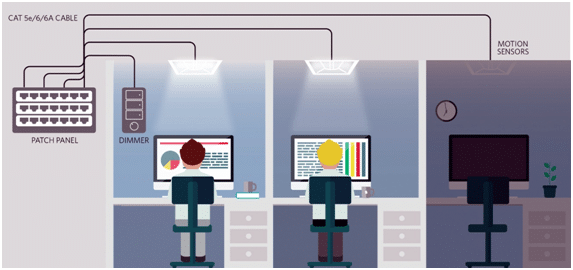In order to stay current, profitable and attract talent, companies need to embrace digital disruption and transformation in their business. One way this can be achieved is with smart lighting, which is a lighting system connected to a network that can be monitored and controlled from a centralized system. According to Gartner, "smart, solid-state lighting in office buildings and industrial installations has the potential to reduce energy costs by 90 percent." One powerful example of smart lighting is PoE (Power over Ethernet) lighting. In the simplest of terms, PoE lighting refers to the ability to use an Ethernet cable to power light fixtures. This easy-to-implement lighting solution can bring not only cost savings to your business, but a multitude of other benefits.
Lower Your Electricity Costs
Perhaps the most notable benefit of PoE lighting is cost savings. Operating costs are lower over the course of the PoE lifetime and PoE installation is cheaper than traditional electrical work— all without sacrificing lighting quality for occupants.
For just a fraction of the cost of other lighting fixtures, and with an extended lifespan, PoE lighting is a money-saving solution. Check out these numbers regarding average yearly costs to operate:
- Incandescent: $13.80
- Operating lifespan: 1 year
- New Halogen: $9.89
- Operating lifespan: 1-2 years
- CFL: $3.22
- Operating lifespan: 6-10 years
- PoE LED: $2.99
- Operating lifespan: 15-25 years
As PoE lighting is more viable where there's existing IT infrastructure, the commercial segment is best suited for deploying PoE solutionsas the installation costs are lower. PoE installation involves structured cabling, as opposed to traditional A/C conduit installation. Structured cabling is also more easily scalable and involves custom software zones as opposed to new circuits.
Gain Access to Advanced Analytics
PoE lighting offers the convenience of a customized dashboard to gain access to advanced analytics, such as energy usage in your business, occupancy details and other miscellaneous sensor data. These analytics can have a significant impact on sustainability, operations and cost-saving strategies. PoE data can provide real-time insights into production costs, operational efficiency and potential problems occurring in areas of your building.
These analytics can be useful and impactful for a wide range of employees. According to a Smart Industry, innovative lighting solutionsaren't just for lighting experts. "Professionals responsible for planning, building, installing, operating and maintaining localized power-generating facilities and equipment need to understand what it is, how it works and why it might be a strategic asset in order to make the best decisions for their project."
For more information on how your business can implement PoE lighting and experience the benefits of an all-encompassing dashboard, reach out to our infrastructure team here.
Improve Employee Productiveness
Have you ever noticed that employees operate differently in different lighting? Some prefer a bright, well-lit environment with warmer tones, while others prefer a more dim, cool setting. PoE provides tunable white lighting (i.e. warm, neutral or cool lighting based on a lumen value). With this feature, employees can adjust their preferred lighting temperature on an individual basis, boosting overall comfort and productivity in the workplace.

Automate Your Lighting
Automation is a key part of advancing any business' technology roadmap and automating lighting can lead to more efficiency in the workplace. Here are 2 ways PoE can help:
Occupancy Sensors
To save on lightings costs and promote a more efficient use of lighting, occupancy sensors essentially control when lights are turned off ordepending on the occupancy in a room. For example, you can have the lights in a meeting room automatically turn on when someone enters the room and triggers the sensor. The lights can be automatically turned off when the space is no longer in use. The same can be done in individual office spaces or even in cubicles.
Advanced Scheduling
Without relying on the occupancy of a room for the lights to turn on, you can schedule lights for certain areas to promote efficient use of lighting, as well. For example, if it's "after hours" in the office and the lights were not shut off when the last person left, you can schedule lights to be automatically shut off at 7 PM to ensure they don't stay on all night.
Utilize More Natural Light
As a method of reducing energy consumption, daylight harvesting is used to reduce electric lighting when daylight, or natural lighting, is available. For example, you can set a specific lumen value of light that you would like your office to be. If the sunlight exceeds the lumenvalue, daylight harvesting will turn the lights off, relying on 100% outside lighting. If there are late-night meetings in the office when there is no sunlight at all, interior lights will compensate to the room to the specified lumen value.














